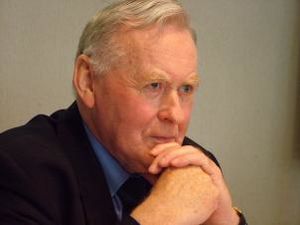Baldur Ragnarsson facts for kids
Quick facts for kids
Baldur Ragnarsson
|
|
|---|---|

Baldur in 2005
|
|
| Born | 25 August 1930 Iceland |
| Died | 25 December 2018 (aged 88) |
| Occupation | novelist, short story writer, essayist, journalist |
| Language | Esperanto Icelandic |
| Period | 1958–2018 |
| Genre | Poetry, Essays |
| Notable work | La lingvo serena |
Baldur Ragnarsson (born August 25, 1930 – died December 25, 2018) was a famous Icelandic poet and writer. He wrote many works in Esperanto, a special international language. Baldur was also a teacher and a school superintendent in Iceland.
Contents
Baldur and the Esperanto Language
Baldur first learned Esperanto at school in 1949. From 1952, he worked hard to help more people use this language. He was the president of the Icelandic Esperanto Association for many years.
What is Esperanto?
Esperanto is a language that was created to be easy to learn. The idea was to have a language that people from different countries could use to talk to each other. This would help bring people closer and make communication easier worldwide.
Baldur's Work with Esperanto
Baldur was very important in the world of Esperanto. He led the World Esperanto Association's writing contest for ten years. He also helped organize the big 1977 World Esperanto Congress in Reykjavík, Iceland. Later, he became a vice-president of the World Esperanto Association, focusing on culture and education. Because of all his hard work, he became an honorary member of this organization.
From 1979, Baldur was a member of the Esperanto Academy. This group helps keep the Esperanto language correct and growing. He also edited a magazine called Norda Prismo for many years. In 2007, a group of Esperanto writers even suggested him for the Nobel Prize in Literature!
Baldur's Writings
Baldur wrote many poems in his native Icelandic. He also wrote books about the Icelandic language itself. But he is especially known for his works in Esperanto.
Poetry
Baldur wrote two collections of poems in Esperanto: Ŝtupoj sen nomo and Esploroj. In 2007, a book called La lingvo serena was published. It included all his poems up to that time, plus his essays about literature and language. He continued to publish more poetry books until 2016.
Here are some of his poetry collections:
- Ŝtupoj sen Nomo, 1959
- Esploroj, 1974
- La lingvo serena, 2007
- La neceso akceptebla, 2008
- La fontoj nevideblaj, 2010
- Laŭ neplanitaj padoj, 2013
- Momentoj kaj meditoj, 2016
Translations into Esperanto
Baldur was also a talented translator. He translated many important Icelandic stories and poems into Esperanto. This helped people around the world learn about Icelandic culture and history.
Some of his famous translations include:
- Sub stelo rigida (poems by Þorsteinn frá Hamri), 1963
- Islandaj pravoĉoj (old Icelandic tales and a poem), 1964
- Sagao de Njal (Njáls saga, one of the greatest Icelandic sagas), 2003
- Sendependaj homoj (Halldór Laxness's Independent People, a novel about old rural Iceland), 2007
- La Edda de Snorri Sturluson (Snorri Sturluson's Prose Edda), 2008
- Vundebla loko (poems by Gerður Kristný), 2009
- Sagao de la Volsungoj - kaj ĝiaj fontoj (the famous Saga of the Völsungs), 2011
- Sagao de Egil (Egil's Saga, one of the famous Sagas of Icelanders), 2011
He also translated many other works that appeared in different magazines.
Essays
Baldur wrote many essays, which are short pieces of writing that explore a topic. His essays often discussed literature and language, especially Esperanto.
Some of his essays include:
- La Sagaoj kaj Zamenhof: stabiligaj faktoroj 1982
- Studado de alia lingvo 1982
- La Poezia Arto (Five lectures) 1988
- Cent jaroj de poezio en Esperanto". 1989
- La poezio de la skaldoj
- La lingvo serena 2007
See also
- List of Icelandic writers
- Icelandic literature

